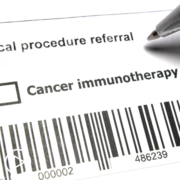What Treatments Are Available for HER2-Positive Metastatic Breast Cancer?
What Treatments Are Available for HER2-Positive Metastatic Breast Cancer? from Patient Empowerment Network on Vimeo.
What are the differences between HR-positive and HER2-negative metastatic breast cancer? Expert Dr. Demetria Smith-Graziani gives a clear breakdown around the differences and encourages patients to ask what the available standard treatments are for HER2-positive metastatic breast cancer.
Demetria Smith-Graziani, MD, MPH is an Assistant Professor in the Department of Hematology and Medical Oncology at Emory University School of Medicine. Learn more about Dr. Smith-Graziani.
[ACT]IVATION TIP
“…ask about the HER2 status of your breast cancer and ask about what the available standard treatments are for HER2-positive metastatic breast cancer, as well as potential clinical trial options.“
Download Guide | Descargar Guía en Español
See More from [ACT]IVATED Breast Cancer
Related Resources:

Practical Questions About Breast Cancer Treatment Patients Should Ask |

An Overview of Breast Cancer Subtypes | Tips for Being Proactive |
|
Transcript:
Lisa Hatfield:
Dr. Smith, can you explain the difference between HR-positive and HER2-negative metastatic breast cancer? And what promising treatments are available for those types of cancer?
Dr. Demetria Smith-Graziani:
So when we look at the cancer cells under the microscope, we test for different proteins, and one of those proteins is called HER2. Breast cancers that overexpress the HER2 protein are considered to be HER2-positive, and those do not have this overexpression are considered to be HER2-negative.
For metastatic or stage IV breast cancer, cancers that are HER2-positive, have the option of being treated with HER2-targeted therapy, and that means that we have certain drugs that will seek out the cancer cells that are expressing these HER2 proteins bind to those cells and deliver treatments to those cancer cells that destroy those cancer cells in a more targeted fashion than traditional chemotherapy that tends to destroy all rapidly dividing cells equally.
So my activation tip for patients is ask about the HER2 status of your breast cancer and ask about what the available standard treatments are for HER2-positive metastatic breast cancer, as well as potential clinical trial options.
Share Your Feedback:
Create your own user feedback survey







